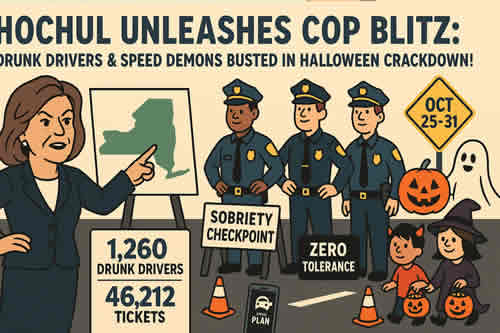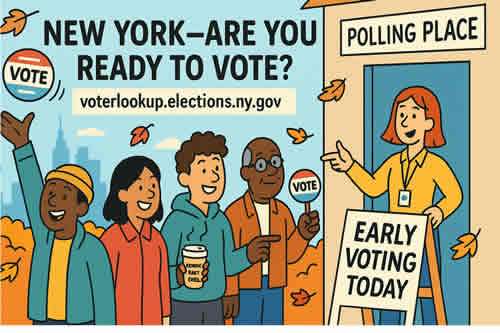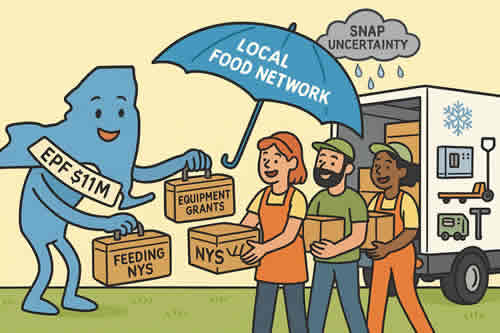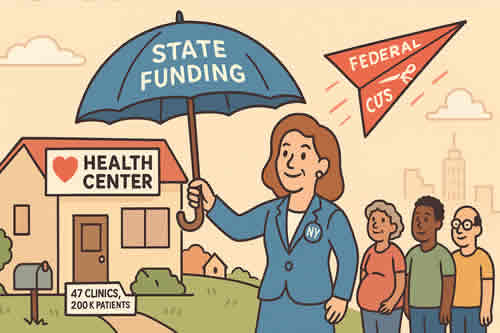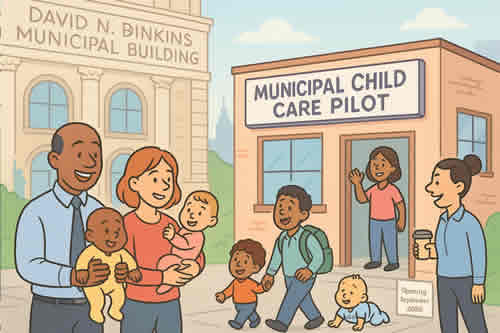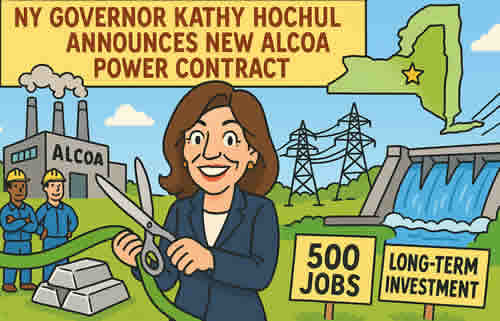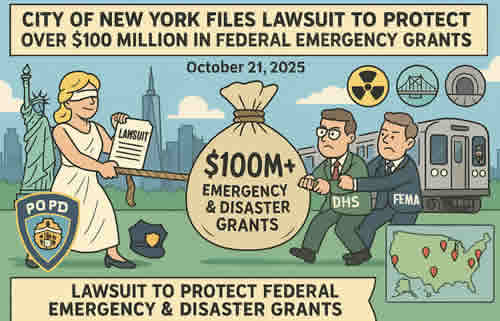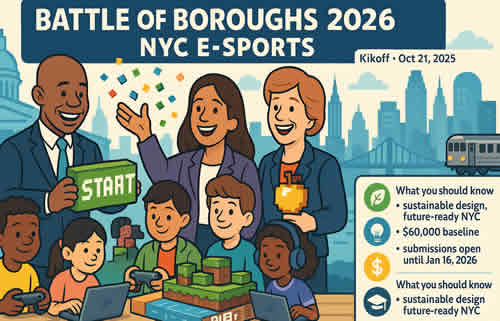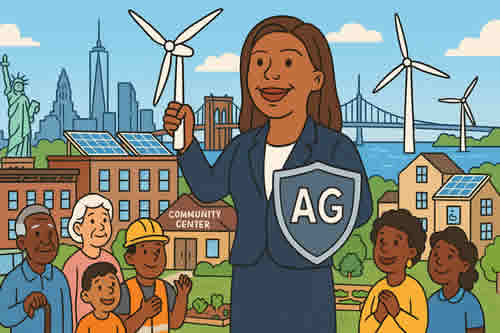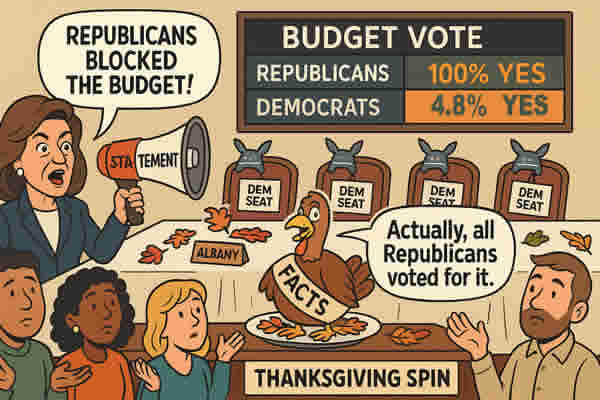
Nearly 3 Million New Yorkers Could Lose Their Food Assistance in November — Ahead of Thanksgiving — Due to GOP’s Federal Government Shutdown. As USDA Refuses To Unlock Federal Funds, Governor Fast-Tracks $30 Million To Support Over 16 Million Meals Statewide, In Addition to the $11 Million In Emergency Food Bank Funds Announced Last Week .
140,000 New Yorkers Will Face a 40% Hike in ACA Health Insurance Premiums Beginning November 1 . Heating Assistance for More than 1.5 Million New Yorkers Delayed Indefinitely As Winter Approaches.
Governor Also Launches New Website For New Yorkers To Share Their Stories About The Impacts of Federal Funding Cuts.
Governor Hochul today rallied with New Yorkers impacted by Washington Republicans’ devastating cuts to health care, food assistance and other critical programs. With nearly three million New Yorkers at risk of losing the food assistance they receive from the Supplemental Nutrition Assistance Program (SNAP) starting November 1 due to the GOP’s federal government shutdown, the Governor also announced that she is fast-tracking $30 million in State funds to support over 16 million meals. This additional funding follows Governor Hochul’s announcement last week of more than $11 million to support local emergency food relief. The Governor’s funding announcements come as federal administrators at the USDA have refused to unlock the federal funding needed to ensure SNAP recipients receive their November food assistance. This would mark the first time in U.S. history that a federal administration has stopped food assistance during a government shutdown.
Additionally, Governor Hochul today launched a new website where everyday New Yorkers can share their personal stories about the devastating effects of Washington Republicans’ cuts to health care, food assistance and other critical programs. The new website — ny.gov/federalcuts — breaks down the impacts on regions across the state and includes relevant resources available to New Yorkers affected by these cuts.
“I am doing everything in my power to soften the blow of the destruction Republicans in Washington are inflicting on our state,” Governor Hochul said. “While I’ve said repeatedly that no state can backfill these devastating cuts, I am committed to ensuring New Yorkers do not go hungry this holiday season and am taking action to support the families suffering the consequences of Republicans’ cruelty. Republicans in Congress voted to rip health care and vital services from millions of New Yorkers and my administration and the people of New York will continue holding them accountable.”
After their Big Ugly Bill stripped nearly two million New Yorkers of their health coverage and is anticipated to result in more than 300,000 households losing SNAP food assistance, the White House is capitalizing on the uncertainty of the government shutdown to create even more chaos. Unless the Trump Administration and Washington Republicans act to end the government shutdown or backfill critical programs, beginning on November 1 New Yorkers face devastating cuts to food assistance, skyrocketing health care premiums, and a loss of other critical programs like heating assistance.
- Nearly three million New Yorkers who rely on SNAP each month to feed themselves and their families may not receive their SNAP benefits in November — ahead of the Thanksgiving holiday
- 140,000 New Yorkers will see their health care premiums skyrocket by nearly 40 percent
- Funds for for the Home Energy Assistance Program (HEAP) are delayed making it harder for more than 1.5 million New Yorkers to afford their utility bills and keep warm as temperatures begin to drop and winter approaches
- Early education in jeopardy across the state with a lack of federal funding to support Head Start programs
- Critical infrastructure projects and jobs will be put at risk with cuts to infrastructure and security funding
Senator Kirsten Gillibrand said, “Republicans in Congress have needlessly shut down the government, and now they’re refusing to work with Democrats to maintain the benefits that put food on the table for millions of New Yorkers. As families across New York face crushing health care costs driven by Trump administration policies that only benefit the wealthiest Americans, House Republicans have left Washington on a taxpayer-funded vacation. It’s time for them to get back to work and finally start partnering with Democrats to lower costs for working families.”
Representative Jerrold Nadler said, “Health care premiums are about to skyrocket and November SNAP benefits for over three million New Yorkers are at risk because of the Republican shutdown. Republicans are threatening to starve low-income Americans for their own political gain. I have called on the Trump Administration to use every tool available to keep food assistance flowing to hungry seniors, veterans, and families with children. The Administration has the authority to cover most November SNAP benefits through the contingency fund and can use its transfer authority to make up the rest. If they refuse to act, it’s a deliberate choice to take food off the tables of millions of Americans. Meanwhile, the House has been out for over a month now and it’s long past time for Republicans to get back to work to help families put food on the table and keep their affordable health care. The Governor’s new website will help New Yorkers across the state find the resources and assistance they need until Republicans come back to the negotiation table and open the government.”
Representative Nydia Velázquez said, “While Republicans in Congress play political games with people’s lives, millions of New Yorkers are being forced to choose between putting food on the table and keeping their health care. These cuts aren’t just numbers, they are families in our communities who will lose coverage, go hungry, or fall deeper into poverty. I applaud Governor Hochul for standing up for New Yorkers and giving them a platform to share their stories. The human cost of these GOP attacks must be seen and heard.”
Representative Gregory W. Meeks said, “Families across Queens and throughout the state are paying the price for GOP cuts to health care and food assistance. Governor Hochul is standing up for New Yorkers while Republicans in Washington put politics over people and enjoy vacation time. This new website is important because it encourages New Yorkers to share their experiences and highlight the damage these reckless Republican policies are doing to our communities. Democrats are fighting to protect food assistance for Americans and improve the cost of living nationwide.”
I am committed to ensuring New Yorkers do not go hungry this holiday season and am taking action to support the families suffering the consequences of Republicans’ cruelty.
Governor Kathy Hochul
Representative Paul Tonko said, “Over the past several months, congressional Republicans have inflicted real pain on families in every corner of our state — stripping away health care, gutting food and home heating assistance, and driving up costs for millions. With open enrollment beginning next month and families bracing for skyrocketing premiums and the loss of SNAP benefits, it’s never been more urgent to ensure that New Yorkers have the resources and information they need to survive. This new initiative gives families the tools to navigate these devastating cuts — and just as importantly, a place to share their stories so we can continue fighting for their priorities against this callous Republican regime.”
Representative Grace Meng said, “I have asked my constituents to share their stories about the impact of higher health care costs, and I’m pleased to see Governor Hochul launching a similar effort for all New Yorkers. I thank her for being such a staunch ally in our fight against GOP cuts that threaten to have devastating impacts on our state. I again repeat my call for Republican leaders to immediately reopen the government and address the healthcare crisis, and I will continue urging them to do so. From health care to food assistance and other crucial services, we must stop the harm impacting New York and communities across the nation.”
Representative Joseph Morelle said, “I’m grateful to Governor Hochul for giving more people the chance to share their stories. While she and our local partners fight to protect our communities, I’ll keep pushing in Washington to stop these cruel cuts and make sure government stands for the people it is supposed to serve.”
Representative Ritchie Torres said, “In the Bronx, SNAP is not an abstract policy. It is the difference between hunger and stability for over 150,000 families. When Republicans in Washington threaten to cut food assistance, they are threatening to take meals off the tables of children, seniors, and working parents in communities like mine. I am grateful to Governor Hochul for fighting to protect New Yorkers from the cruelty of these cuts and for standing with those who have the least.”
Representative Dan Goldman said, “Donald Trump and his New York Republican allies insist on tearing away health care and food assistance from millions of families to benefit their billionaire buddies. While Democrats in Congress stand ready to address the cost-of-living crisis and reopen the government, the Republican-led House hasn’t voted in over a month. I’m grateful Governor Hochul is stepping up to help New Yorkers tell their stories and get the help they need, and I’ll keep doing everything I can to hold Republicans accountable for this cruel and damaging agenda.”
Representative John W. Mannion said, “Withholding SNAP benefits from millions of American children, seniors, and veterans is the wrong choice by the Trump administration. As I’ve said before, Congress has already approved billions of dollars in contingency funds that could be used right now to protect people’s health and safety. I’m grateful to Governor Hochul for giving New Yorkers a voice to share how these cruel and unnecessary cuts are affecting their lives. I’ll keep fighting to make sure no one in our state goes without food, health care, or basic support.”
Representative Timothy Kennedy said, “As families in Western New York are struggling to make ends meet, Washington Republicans are pulling the rug out from under them — gutting their healthcare, taking food off their tables, and leaving working people to pay the cost of their chaos. I thank Governor Hochul for being a strong partner in protecting New Yorkers from these cruel and reckless cuts. While Congressional Republicans play politics with people’s lives, in New York we’re putting working families first and fighting to cancel these cuts.”
State Senator Gustavo Rivera said, “This new portal launched by Governor Hochul will give New Yorkers the opportunity to share their stories of the devastating impacts of Trump’s HR1 cuts. Millions of New Yorkers are about to see their healthcare and energy costs significantly increase. Families will lose SNAP benefits that they rely on to buy groceries. Our state will need to step up to lessen the impact of these egregious cuts and support constituents who have been betrayed by Washington Republicans.”
State Senator Roxanne J. Persaud said, “These reckless federal cuts are not just numbers on a budget, they represent real people who will struggle to put food on the table, afford their medication, or keep their homes warm this winter. The impacts will have a lasting effect, and we must stand united to protect New Yorkers from Washington’s political games to ensure that no family is left behind.”
Assemblymember Andrew Hevesi said, “These cuts to our health care, food assistance, and energy programs are not abstract numbers — they are intentional decisions to harm children, families, and people from every corner of our state. If we’ve learned anything from the collective demonstrations across the country, it’s that Americans won’t be fooled by this administration, its lies, or repeated failures to live up to its promises. I encourage every New Yorker to visit this new website and see how far-reaching these impacts truly are — and I thank Governor Hochul for her continued leadership, as well as Speaker Heastie for ensuring the Legislature stands united.”
New York Common Pantry Executive Director Stephen Grimaldi said, “As a boots-on-the-ground emergency food provider, we are seeing a surge in the number of people seeking our help. The loss of SNAP dollars will impact millions of New Yorkers. These SNAP figures aren’t just numbers on a page; they’re empty plates in our neighbors’ homes.”
Christine C. Quinn, President & CEO of Win said, “There is nothing ‘beautiful’ about the One Big Beautiful Bill—it’s a recipe for starvation and suffering. These cruel federal policies are colliding with an immediate crisis: SNAP benefits will run out in just days, leaving millions of children across the country—hundreds of thousands here in New York City—without food. At Win, we see this every day—thousands of homeless children and babies who depend on these benefits will go hungry if Washington doesn’t act. We applaud Governor Hochul for her leadership and for keeping this issue front and center, especially as we approach Thanksgiving—a time when no family should have to worry about whether their child will eat. The actions coming from out of Washington would push New York into fiscal and human crisis, forcing parents to make impossible choices between food and rent, medicine and shelter. We are sounding the alarm—City, State, and Federal leaders must act now, before this catastrophe becomes irreversible.”
If you are a New York State resident who uses SNAP, you will be notified by November 1 of any official updates regarding the status of your November benefits.
October 27, 2025
Albany, NY
Midtown Tribune Ed.:This statement by Governor Hochul contradicts the facts: all Republicans voted for the budget, and eight additional Democratic votes were needed to reach the 60-vote threshold.
As of late October 2025, the tally in the United States Senate shows that a funding measure to avoid a shutdown (advanced via cloture) needs 60 votes to proceed, under the usual threshold for ending debate. Good Morning America+2crfb.org+2
The most recent vote on the Republican-backed continuing resolution recorded 52 yeas (including three Democrats/Independent-caucus votes) and 42 nays. The Guardian+2Good Morning America+2
Thus, to reach the 60-vote threshold, 8 more votes would have been needed (60 − 52 = 8).
So, in short: eight Democratic (or Democratic-caucus) votes were still missing for the measure at that point. #shutdown
Here are the numbers from that 52–42 cloture vote:
- Democratic caucus (Democrats + King/Sanders): 3 “Yes” out of 44 who voted ⇒ 6.8% voted Yes.
- Registered Democrats only: 2 “Yes” out of 42 who voted ⇒ 4.8% voted Yes.
- Democrats not voting: 3 (Booker, Heinrich, Rosen). U.S. Senate
Souires: Governor.ny.gov , Midtown Tribune news

